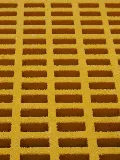loading...
- No. 9, Xingyuan South Street, Dongwaihuan Road, Zaoqiang County, Hengshui, Hebei, China
- admin@zjcomposites.com
- +86 15097380338
- Welcome to visit our website!
Solid Top Grating in GRP for Durable and Aesthetic Applications
The Versatility and Importance of GRP Solid Top Grating
In contemporary construction and industrial applications, platforms, walkways, and drainage systems require materials that ensure safety, reliability, and longevity. One material that has gained significant attention is GRP (Glass Reinforced Plastic) solid top grating. This innovative solution marries strength with lightweight properties, making it ideal for a variety of environments.
Understanding GRP Solid Top Grating
GRP solid top grating is composed of a fibreglass-reinforced polymer, which consists of a thermosetting resin and glass fibres. This combination results in a product that boasts high mechanical strength while remaining lightweight. The solid top design provides a smooth, slip-resistant surface, which is essential in settings where safety is paramount. Available in various thicknesses and sizes, GRP grating can be customized to meet specific load-bearing requirements.
Key Benefits
1. Lightweight and Easy to Install One of the standout features of GRP solid top grating is its lightweight nature compared to traditional materials like metal or concrete. This characteristic not only makes transportation easier but also simplifies installation. Fewer workers and less equipment are required, reducing overall labor costs and minimizing project timelines.
2. Corrosion Resistance GRP grating is inherently resistant to corrosion caused by chemicals, saltwater, and atmospheric conditions. This makes it particularly suitable for environments such as marine applications, wastewater treatment facilities, and chemical plants, where exposure to harsh elements is frequent. Unlike metal grating, which can rust and deteriorate over time, GRP maintains its structural integrity, ensuring long-lasting performance.
3. Safety Features The solid top surface of GRP grating provides excellent traction. This enhances safety for foot traffic in any industrial or commercial setting. Additionally, it eliminates the risk of small items falling through, making it a preferred choice for areas where storage or spills may occur. The material is also fire-resistant, further bolstering its safety credentials.
grp solid top grating

4. Design Flexibility GRP solid top grating is available in various colors and styles, allowing for aesthetic versatility. This adaptability makes it an attractive choice for commercial applications, as it can complement the existing décor of a facility. Furthermore, the grating can be easily molded or shaped, making it suitable for bespoke projects.
Applications
The applications for GRP solid top grating are vast and varied. Common uses include
- Walkways and Platforms Ideal for pedestrian walkways in industrial settings, ensuring safety and durability. - Drainage Covers Providing a reliable solution for drainage systems that require a solid surface to prevent debris accumulation. - Mezzanine Floors Offering a robust platform that can support significant weight while remaining lightweight. - Marine and Coastal Applications Its resistance to saltwater and chemical exposure makes it ideal for docks and marine environments.
Environmental Considerations
In today’s world, the environmental impact of construction materials is a significant concern. GRP solid top grating addresses this issue as well. Its long lifespan reduces the need for frequent replacements, thereby minimizing waste. Moreover, the manufacturing process of GRP can be designed to meet environmental standards, allowing for a more sustainable approach to construction.
Conclusion
GRP solid top grating is an excellent choice for those seeking a combination of safety, durability, and aesthetic appeal. With its lightweight nature, resistance to corrosion, and flexibility in design, it stands out as a versatile option for a wide range of applications. As industries continue to seek innovative solutions that balance functionality with sustainability, GRP solid top grating is poised to become even more integral to modern construction and industrial practices. Embracing this advanced material not only enhances operational efficiency but also contributes to creating safer and more environmentally-friendly workspaces.
-
GRP Structures: The Future of Lightweight, High-Performance EngineeringNewsJun.20,2025
-
FRP Water Tank: High-Performance Storage for Corrosive and Clean Water SystemsNewsJun.20,2025
-
FRP Square Tube: The New Industry Standard for Chemical and Structural ApplicationsNewsJun.20,2025
-
FRP Pultruded Profiles: The Ultimate Choice for Lightweight Structural StrengthNewsJun.20,2025
-
FRP Handrails: The Safer, Smarter, and Stronger Choice for Modern InfrastructureNewsJun.20,2025
-
FRP Grating: The Smart Solution for Durable, Lightweight Industrial FlooringNewsJun.20,2025
-
Why Choose a Galvanized Water Tank for Your Storage NeedsNewsMay.21,2025
